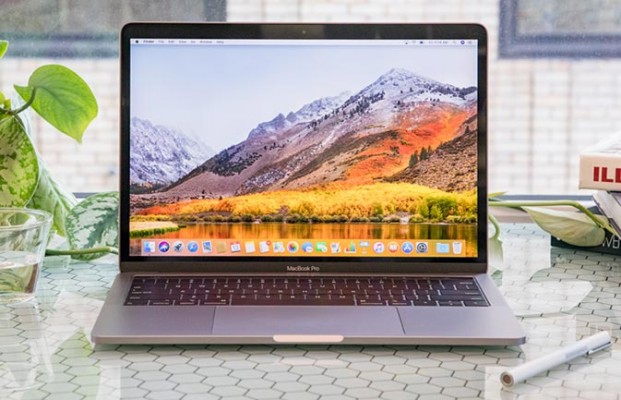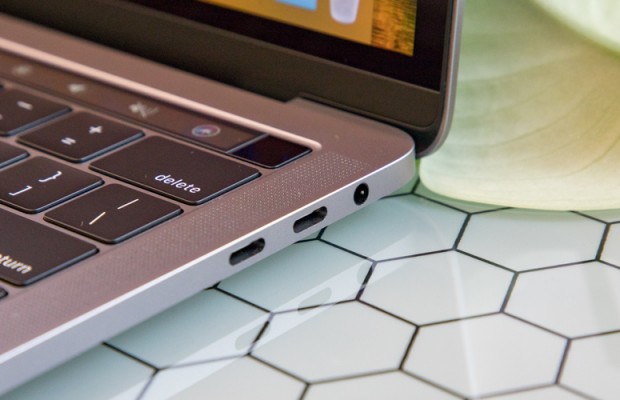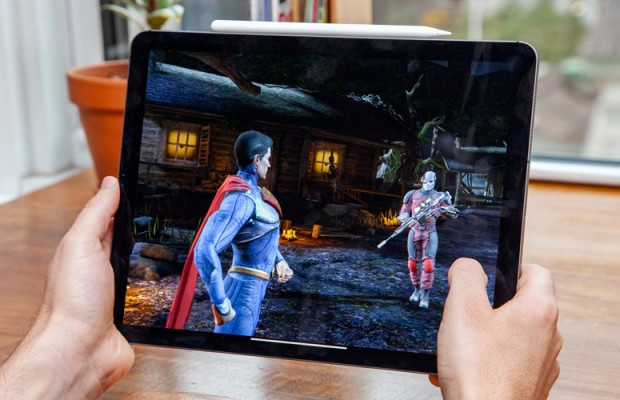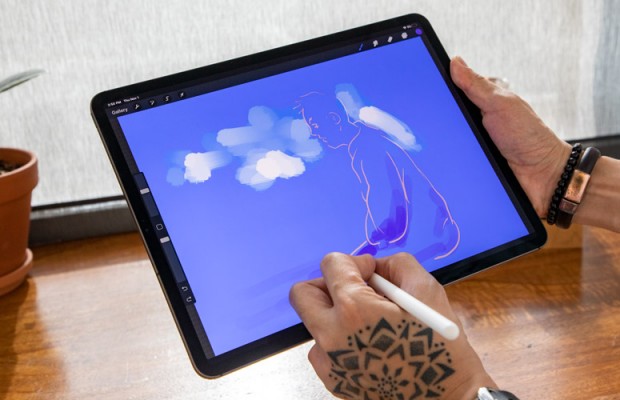MacBook Pro vs iPad Pro: Which Should You Buy?
You might want to sit down for this: The iPad Pro is more powerful than the MacBook Pro. No, seriously — it's not even close on some benchmarks.
The tablet thrashed the competition on each of our tests, outperforming our favorite premium 13-inch laptops by a wide margin. This asks the question: Why buy a laptop if you can run demanding programs on a tablet?
iPad Pro vs 13-inch MacBook Pro: Specs Compared
| Row 0 - Cell 0 | iPad Pro (12.9 inch) | Apple MacBook Pro 13-inch |
| Starting Price | $999 | $1,799 ($2,499) |
| Colors | Silver, Space Gray | Silver, Space Gray |
| Display | 12.9 inches (2732 x 2048 pixels) | 13.3-inch, 2560 x 1600-pixel |
| CPU | A12X Bionic | 8th Gen Core i5, i7 |
| RAM | 4GB | 8GB, 16GB |
| SSD | 64GB, 256GB, 512GB, 1TB | 256GB, 512GB, 1TB, 2TB |
| Keyboard Travel | 0.7mm | 0.55mm |
| Ports | USB-C, Nano-SIM | 4 Thunderbolt 3, headphone |
| Webcam | 7MP (front); 12MP (rear) | HD (720p) |
| Size | 9.7 x 7 x 0.2 inches | 12 x 8.4 x 0.6 inches |
| Geekbench 4 | 17,995 | 17,348 |
| Battery Life (hrs:mins) | 13:14 | 8:43 |
| Weight | 1.4 pounds | 3 pounds |
Recognizing the power of Apple's new tablet, Reddit user OW53 asked for advice on ther/ipad subreddit on which device they should purchase for college: the iPad Pro or the 13-inch MacBook Pro.
Here's how Apple's two powerhouses stack up.
Design
Apple removed the Home button and trimmed down the bezels on the iPad Pro, resulting in a more immersive viewing experience on the new rounded Liquid Retina display. The silver-or-gray aluminum design was also tweaked with flat sides and hard corners, giving it an undeniably industrial look. Apple's Face ID system replaces the Touch ID sensor, allowing users to unlock the tablet in any orientation using facial recognition.
Sign up to receive The Snapshot, a free special dispatch from Laptop Mag, in your inbox.
The MacBook Pro's design hasn't changed much over the years. The sleek unibody aluminum laptop has a solid, premium feel, although we wish its bezels were given the same treatment as the iPad's. A Touch ID button is built into the Touch Bar, making it a breeze to log in with the touch of a finger.
At 3 pounds and 12 x 8.3 x 0.6 inches, the 2018 MacBook Pro is considerably larger and heavier than the 12.9-inch iPad Pro (1.7 pounds, 11.5 x 7.9 x 0.3 inches).
Winner: iPad Pro.
Ports
The iPad Pro has a single USB-C port that connects to monitors, cameras, and if you need more ports, external hubs. There is no 3.5mm jack, so you'll have to buy Bluetooth headphones or use an adapter to use wired cans.
The MacBook Pro retains its four Thunderbolt 3 connections. USB-C is a versatile port but we wish there were a microSD card slot and a USB Type-A for expanding storage and connecting to peripherals.
Winner: MacBook Pro
Display
Both the iPad Pro and MacBook Pro have gorgeous displays, but Apple's tablet performed better in our benchmarks.
According to our colorimeter, the iPad Pro's 12.9-inch, 2732 x 2048 Liquid Retina display can reproduce 128.4 percent of the sRGB spectrum at an excellent color accuracy of 0.29 (0 is perfect). The display should also be plenty visible outside as it reached a blinding 484 nits of maximum brightness.
The MacBook Pro's 13.3-inch, 2560 x 1600-pixel display covers 119 percent of the sRGB color gamut. That's a very good result, but short of what the iPad Pro achieved. Similarly, the MacBook Pro illuminated to an excellent 439 nits but is still dimmer than the iPad Pro.
MORE: Apple AirPods 2 Launch Looks Imminent
Both devices feature Apple's True Tone technology, which dynamically changes the color temperature of the iPad Pro's and MacBook Pro's displays based on ambient lighting to relieve eyestrain.
Winner: iPad Pro
Keyboard
The iPad Pro may have dominated the performance round, but it's important to consider the overall usability of the tablet. If you're going to use the iPad Pro as a true laptop, you'll need to purchase the Apple Pencil ($199) and the Smart Keyboard ($129) accessories. We have no qualms with the stylus, which is now easier to dock and more comfortable to hold, but the keyboard is a serious roadblock in the iPad Pro's quest to replace your laptop.
First, the Smart Keyboard lacks a touchpad. Although that may not seem like a huge deal on a touch-screen device, your arm will grow tired reaching out to tap the display when the iPad Pro is in laptop mode. The other physical disadvantage of the iPad Pro is that it can be tricky keeping the tablet steady when using it on your lap. That can be a serious annoyance for students who need to get work done wherever it is most convenient. And for what it's worth, the keyboard isn't backlit, either.
That said, the iPad Pro's detachable keyboard is relatively comfortable to type on, despite its shallow 0.5-millimeter key travel. I typed 100 words per minute at an accuracy rate of 93 percent on the 10fastfingers.com typing test, just below my typical 109 wpm at 95 percent accuracy.
The MacBook Pro's new Butterfly keys are an improvement over last year's unreliable keyboard, but they're still extremely shallow, with just 0.6 mm of travel. Thanks to its 61 grams of actuation force, I scored 114 wpm with an 8 percent error rate on the typing test. The large, responsive touchpad gives the MacBook Pro a big advantage over the iPad Pro as a primary productivity machine.
Winner: MacBook Pro
Performance
Any doubts you have about the iPad's performance should be put to rest. The new, 12.9-inch iPad Pro (A12X Bionic) crushed our benchmark tests, with a resounding multicore score of 17,995 on the Geekbench 4 overall performance test. The MacBook Pro (8th Gen Core i7 CPU) trailed the iPad by a bit, scoring a 17,348.
On our video editing test, the iPad Pro took 7 minutes and 47 seconds to convert a 4K clip to 1080p in Adobe Rush. That's more than three times faster than the new 8th Gen Core i7 CPU-equipped MacBook Pro, which took 25 minutes and 53 seconds.
The iPad Pro also came out on top when we exported 100 raw photos in Adobe Lightroom. The iPad Pro needed just 59 seconds to complete the task, while the MacBook Pro took 1 minute and 35 seconds.
MORE: Apple Pencil 2 Will Fix the Original's Worst Flaw
The iPad Pro supposedly has twice the graphics power as its predecessor, so it should compare favorably to the MacBook Pro, which disappointed in our graphics test (running Dirt 3 at only 47 frames per second). NBA 2K19 and Assassin's Creed Identity looked gorgeous in Apple's demo, but we'll need to spend some time playing with them to see if they're really Xbox One S quality.
Winner: iPad Pro
Battery Life
The iPad Pro is the undisputed battery life king between these two devices. The tablet lasted an outstanding 13 hours and 14 minutes on our battery test, which involves continuous web surfing over Wi-Fi at 150 nits. That is a resounding 4-plus hours longer than the 13-inch MacBook Pro, which disappointed with a runtime of 8 hours and 43 minutes.
Winner: iPad Pro
Software: macOS vs iOS
The iPad Pro runs the best version of iOS yet. iOS 12 brings improved notifications, new gestures and fancier markup tools to its mobile operating system. But despite migrating over desktop features, iOS 12 remains just that, a mobile OS.
Safari on the iPad Pro isn't up to scratch with its desktop counterpart, macOS. The web browser will direct you to apps instead of loading full web pages, whereas its competitor, Chrome OS, offers a full web browser alongside Android apps. The Files app is not as comprehensive as Finder on Mac, app-switching while multitasking isn't trivial and you can't watch 4K YouTube videos.
These are small issues, but they add up. A bigger problem, however, is that apps like Final Cut Pro — a favorite among video editors — are not available on the iPad (though Photoshop is coming soon).
On the flip side, iOS 12 is easy to navigate and has a simpler, more refined interface than macOS. If you've ever owned an iPhone, you know that the biggest benefit of iOS over macOS is its rich, vast library of mobile apps.
Winner: Draw.
Pricing and configurations
Get your credit card ready, both of these devices will cost you more than $1,000. The 12.9-inch iPad Pro starts at $999 for a 64GB model and jumps to $1,149 for 256GB. Doubling the storage capacity to 512GB will run you $1,349, and doubling it again to 1TB raises the price to $1,749. The Smart Keyboard accessory will run you an extra $199, and the Pencil goes for $129.
The 13-inch MacBook Pro with Touch Bar is extremely expensive. You'll spend $1,799 for a Core i5 CPU, 8GB of RAM and a 256GB SSD. Upgrading the CPU to a Core i7 adds another $300, and doubling storage to 16GB is an extra $200. You can configure the MacBook Pro with up to 2TB of SSD storage, but doing so will set you back another $1,400. A maxed-out MacBook Pro costs a resounding $3,699.
Winner: iPad Pro
Bottom Line
The iPad Pro makes a compelling case as an alternative to the MacBook Pro. Apart from its blazing-fast performance and long battery life, the tablet is more portable than the 13-inch laptop, at 2.4 pounds with the keyboard accessory. And while iOS isn't ready to replace macOS, it does feature a massive library of apps that will soon include a full version of Photoshop.
| Row 0 - Cell 0 | Apple iPad Pro (12.9 inch) | Apple MacBook Pro 13-inch |
| Design (10) | 9 | 7 |
| Ports (10) | 3 | 6 |
| Display (15) | 13 | 12 |
| Keyboard/Touchpad (10) | 3 | 6 |
| Performance (20) | 19 | 17 |
| Battery Life (20) | 19 | 14 |
| Value (10) | 7 | 5 |
| Overall (100) | 73 | 67 |
Given the limitations of iOS, the iPad Pro remains a great secondary device and a good primary machine for consuming content, but it's not necessarily the best for creating it. For that reason, we recommend that creators and those who need to run demanding programs buy the MacBook Pro, which supports expandable storage, sports a large trackpad and is easier to use on your lap.
Credit: Laptop Mag
Phillip Tracy is the assistant managing editor at Laptop Mag where he reviews laptops, phones and other gadgets while covering the latest industry news. After graduating with a journalism degree from the University of Texas at Austin, Phillip became a tech reporter at the Daily Dot. There, he wrote reviews for a range of gadgets and covered everything from social media trends to cybersecurity. Prior to that, he wrote for RCR Wireless News covering 5G and IoT. When he's not tinkering with devices, you can find Phillip playing video games, reading, traveling or watching soccer.









